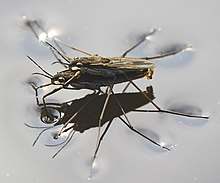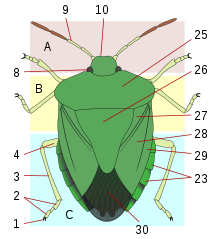Heteroptera
| Heteroptera Temporal range:
| |
|---|---|

| |
| Two water striders mating
| |
| Scientific classification | |
| Domain: | Eukaryota |
| Kingdom: | Animalia |
| Phylum: | Arthropoda |
| Class: | Insecta |
| Order: | Hemiptera |
| Suborder: | Heteroptera Latreille, 1810 |
| Infraorders | |
| |
The Heteroptera are a group of about 40,000 species of insects in the order
The name "Heteroptera" is used in two very different ways in modern classifications. In
The infraorders Leptopodomorpha, Gerromorpha, and Nepomorpha, comprise a significant component of the world's aquatic and semiaquatic insects. There are 23 families, 343 genera and 4,810 species group taxa within these three infraorders.[2] Most of the remaining groups that are common and familiar are in the Cimicomorpha and Pentatomomorpha.
Classification

The use of the name "Heteroptera" has had the rank of
In one revised classification proposed in 1995,
In the traditional classification,
Alternatively,
Separate from the question of the actual "closeness" of Heteroptera and Coleorrhyncha is the potential disruption to traditional construction of names; there seems to be reluctance among hemipterists to abandon the use of "Heteroptera". This can be seen by the name itself, as it is a violation of convention to use the ending "-ptera" for any rank above genus other than an order – though since it is a convention rather than a mandatory rule of Linnean nomenclature, taxonomists are technically free to violate it (which is why, for example, not all insect orders end in "-ptera", e.g., Odonata). However, in most cases when such conventions are violated, it does not create an internal conflict as in the present case (that is, the order Hemiptera has a suborder named Heteroptera, which is an internal conflict). At least some hemipterists argue that the name Heteroptera should be dropped entirely to eliminate this internal conflict, though the third possibility offers a workaround. In that case, to achieve full consistency of names "Coleorrhyncha" would probably be dropped in favor of "Peloridiomorpha".
References
- ^ Tree of Life Web Project (2005): Heteroptera. True bugs. Version of January 1, 2005. Retrieved July 28, 2008.
- S2CID 45657091.
- ^ Sorensen, J. T., B. C. Campbell, R. J. Gill & J. D. Steffen-Campbell (1995): Non-monophyly of Auchenorrhyncha ("Homoptera"), based upon 18S rDNA phylogeny: eco-evolutionary and cladistic implications with pre-Heteropteroidea Hemiptera (s.l.) and a proposal for new monophyletic suborders. Pan-Pacific Entomologist 71 (1): 31–60.
- ^ Maddison, David R. (1995): Tree of Life Web Project – Hemiptera. True bugs, cicadas, leafhoppers, aphids, etc.. Version of January 1, 2005. Retrieved July 28, 2008.
- ^ Cassis, Gerasimos & Gross, Gordon (1995): Australian Biological Resources Study – Hemiptera: Heteroptera (Coleorrhyncha to Cimicomorpha). Gerrids, Reduviids, Water-striders. Version of June 30, 1995. Retrieved July 28, 2008.
Further reading
- China, W.E.; Miller, N.C.E. (1959). "Check-list and keys to the families and subfamilies of the Hemiptera-Heteroptera". Bulletin of the British Museum (Natural History), Entomology. 8 (1). London: British Museum: 1–45.
External links
- Heteropteran Systematics Lab at University of California, Riverside http://heteroptera.ucr.edu
- Identification guide to UK Hemiptera
